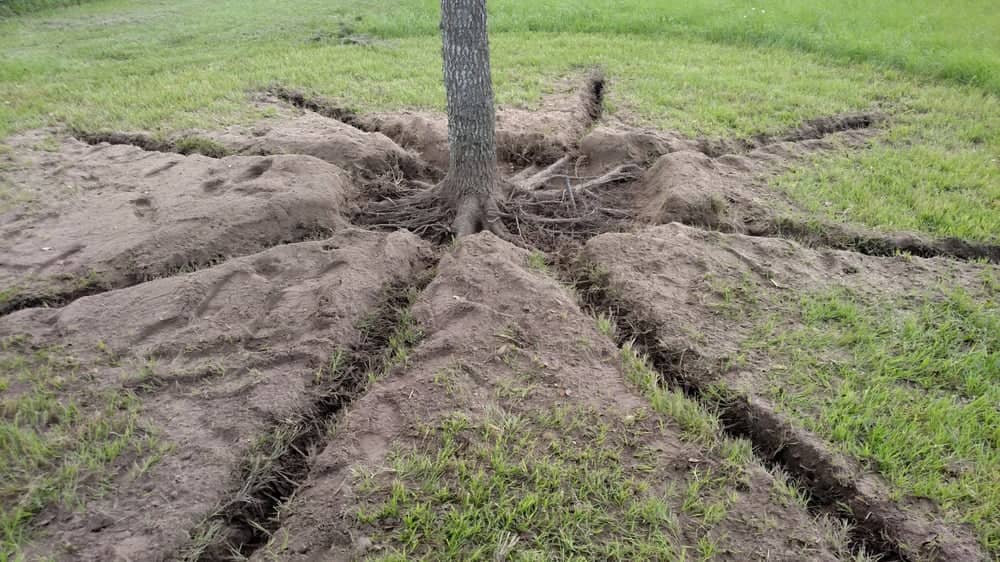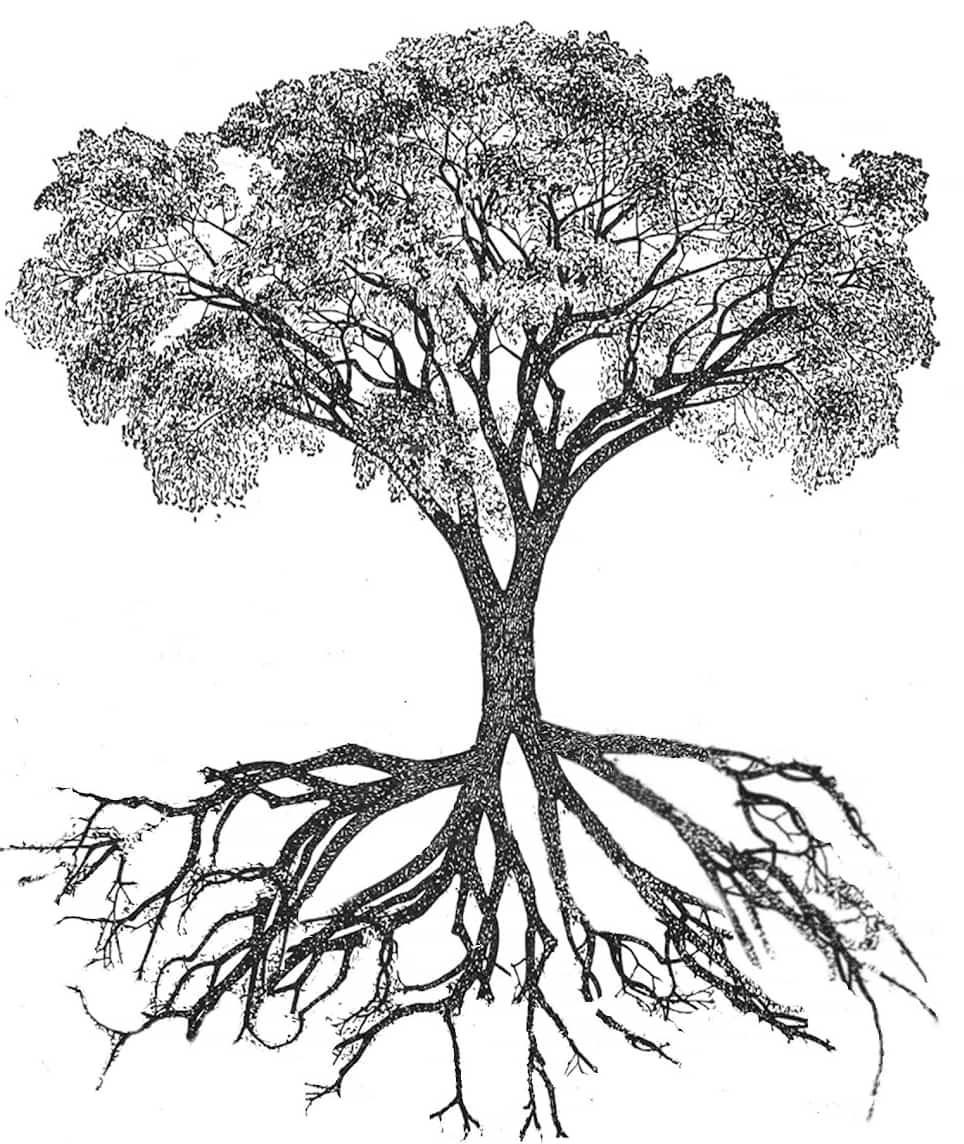
Root Excavation Services
Friendly Tree utilizes an Air Spade, which is a state-of-the art excavation tool that is revolutionizing the arboricultural industry. The Air Spade uses great volumes of compressed air to remove and break up soil — even clay — without damaging roots, cables or buried utility lines. Breaking up soil compaction in the critical root zone was always a bit of a gamble in the past as many roots were damaged in the process. The focused air stream cuts through soil quickly and with great accuracy in considerably less time than conventional digging, allowing for more efficient service.
Help For Root and Soil Problems
Problems with roots and soil often lead to plant decline and ultimate failure. Friendly Tree Air Spade services now uses this powerful handheld device to expose root systems, allowing our team members a clear picture of the overall tree from tip-top of the canopy all the way down to root tip. With this information, diagnosing and treating plant and tree problems can be done more effectively and efficiently than in the past that may have been difficult or impractical.
Why Root Excavation?
Countless trees suffer from collar rot. This is an invisible killer as it generally lies beneath a thick layer of dirt and or mulch at the base of the tree. Collar rot is a symptomatically described disease that is usually caused by any one of various fungal and oomycete plant pathogens. It is present where the pathogen causes a lesion localized at or about the collet between the stem and the root. Soil compaction and poor soil quality can speed the process and ultimately kill your valuable trees and shrubs. These conditions combined with many homeowners and landscapers that do not plant trees correctly, and often times lead to girdling roots. A tree is girdled when something is tightly wrapped around the trunk or stem. A stem girdling root circles or partially circles the base of a tree at or just below the soil surface.
Stem girdling roots choke off the flow of water and nutrients between the roots and branches and food produced in the leaves from reaching the roots. They can also compress and weaken the trunk of a tree at or above the root collar flare (the junction between the trunk and the main roots) causing it to lean and lose its stability. Girdling roots may girdle other roots, but there is no known harm in this. Trees having stem girdling roots suffer a slow decline in health and a premature death.
- Safe and effective means of clearing excess soil and mulch from the root collar without damaging the tree to expose girdling roots
- Immediate visual inspection and correction of specific plant health concerns
- Quick, accurate diagnosis of plant diseases and the extent of decay without extensive root system damage
- One step aeration and soil replacement to reduce soil compaction
- Trench with minimum disturbance of roots during utility or construction projects
- Facilitates application of specially blended materials to promote root growth and survival rate
- Air spading can accurately reveal the cause of declining plant health in an otherwise healthy row of trees or shrubs
Air Spade Uses
- Expose root flares of trees planted too deeply which is way too common
- Expose root flares of trees covered with fill dirt generally after construction projects
- Expose root flares and root structure 6” to 18” below grade for base investigation which allows a near full 360degree picture of the overall tree from top to bottom
- Digging trenches for utilities, electric and gas lines or even sprinkler lines and speaker wire for outdoor entertainment areas without cutting tree roots or concrete
The root flare or root collar is the area where a tree begins to taper outward at ground level. This is a critical part of the tree where trunk tissue changes into root tissue. If this area is covered with soil and kept moist for extended periods of time, the tissue begins to breakdown. This leaves the tree vulnerable to root decay and ultimately poor health and vigor.
Base investigation is needed when an arborist suspects deterioration of root tissue. Since roots can not be seen above the surface, the only way to confirm this suspicion is to excavate the soil and inspect the root structure.
What to Expect: Air Spade Process
Preparing the Soil — Water the soil area around the tree one or two days prior to the Air Spade work being done. This will soften the soil and expedite the process as well as cut down on the dust of dry soil.
Clearing the Work Area — The work area around the tree will need to be prepared. Prior to the movement of soil, we will remove any grass, ivy, shrubs, or flowers from around the base of the tree. This work area is typically one to two feet from the base of the tree. We do not preserve the vegetation in most cases and request you salvage any plant material you want to keep. We do not replace the vegetation removed.
Loud and Dirty Process — Due to the high pressure air being used and a large scale compressor needed to power the operation the process can be quite noisy.
Backfilling the Excavated Area — When excavating a root flare, the void created can sometimes be quite deep. If the area cannot be left open, it can be filled with coarse mulch. When the area exposed is greater than eight inches deep, medium to large stone can be used to backfill the area insuring greater air circulation around the base. We will recommend amending the soil appropriate to your trees location and specific needs. Soil chemistry and texture as well strata can vary wildly even in the same yard. Generally we utilize Terra-Gro which is a rich, organic and coarse mulch we process in-house.
Vertical Mulching & Radial Trenching
Both vertical mulching and radial trenching have been criticized by some researchers because these processes only affect a small area of soil and roots that are adjacent to the trench or the vertical holes. Some critics of vertical mulching and radial trenching generally prefer the stirring of the compost into the upper few inches of soil. Too much root work can stress the tree.
Vertical Mulching
Vertical Mulching is the process of making vertical holes in the soil usually where fill soil has been added over roots or where compaction with heavy equipment has occurred over the roots. The once-restricted root is then able to grow into these holes to freely exchange needed gases with the atmosphere — for trees, this is as essential as breathing is to us. Vertical mulching will also lessen damage due to excessive water, preserve necessary aeration during wet periods, allow sub-soil water penetration during dry periods, and promote the formation of fine feeder roots. Mycorrhizae fungi or beneficial root fungi can aid this process greatly. Each tree and critical root zone is different.
Do I Need Vertical Mulching?
- If your tree has been damaged during construction by heavy equipment working in the critical root zone compressing the soil etc (https://friendlytree.com/tree-inspections-tree-evaluations-and-tree-consulting/ )
- If the soil around your tree has become “tight” around the tree and or looks like it is “baked” by the sun the tree is being suffocated. If air cannot penetrate compacted soil neither can ground water and micro/macro nutrients
- If the tree is in a poor drainage area
- If for some reason, any reason your trees roots are not breathing properly.
Radial Trenching
Radial trenching is a treatment performed on trees growing poor or depleted soils and or in compacted soils. Friendly Tree Radial trenching allows oxygen to reach the roots in the critical root zone, allows for replacement of poor soil and to alleviate compaction in the critical root zone.
Radial trenching is performed using an Air Spade to remove soil radially from the trunk out to the roots. Narrow trenches are created using high air pressure in a radial pattern throughout the root zone. These trenches appear similar to the spokes of a wagon wheel. Trenches will be 8-12 inches deep 3-4 inches wide. Using high pressure air tools causes minimal root damage.
Narrow trenches are dug in a spoke pattern around the tree, then backfilled with topsoil or compost. Root growth in the trenches will exceed root growth in the surrounding soil. A 2- to 4-inch layer of wood chips may also be added over the top of the backfilled trenches. The narrow trenches can be backfilled with the topsoil or compost. Root growth will be greater in the trenched area than in the surrounding soil. This can give the tree the added boost it needs to adapt to the compacted soil or new grade.



